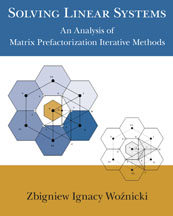 Matrix
Editions
Matrix
Editionsserious mathematics,
written with the reader in mind
 Matrix
Editions
Matrix
Editions
serious mathematics,
written with the reader in mind
 ISBN-13: 9780971576667
ISBN-13: 9780971576667
554 pages, 8 x 10 inches, hardcover, smythe-sewn binding
More than 230 figures and 140 tables
Please consider recommending that your university or department librarian order this book. Thank you!
Foreword by Richard Varga
Chapter 0 Introduction to iterative methods and preconditioning
Chapter 1 Numerical linear algebra: background
1.1 Review of matrix theory
Basic matrix operations
Matrix partitionings
Basic concepts of matrix analysis
Vector norms and matrix norms
Computational work
1.2 Eigenvalues and eigenvectors
Relating norms and eigenvalues
Convergence of vector and matrix sequences
Perron-Frobenius theory of nonnegative matrices
Diagonally dominant matrices
Power method
1.3 General linear systems
Direct methods
Iterative refinement
2.1 General properties of matrix splittings
2.2 Regular splittings
2.3 Nonnegative and weak nonnegative splittings
2.4 Weak and weaker splittings
2.5 Summary
3.1 Finite-difference approximations
3.2 One-dimensional problems
Forward elimination - backward substitution
Backward elimination - forward substitution
3.3 Band matrices
Pentadiagonal matrices
General band systems
3.4 Two-dimensional problems
Rectangular geometry
Triangular geometry
Hexagonal geometry
Reduced systems
Line orderings
Computational molecules
Irregular mesh structures
3.5 Test problems
4.1 General theory of iterative methods
Stopping criteria
Starting vectors
4.2 Point iterative methods
Basic algorithms
Consistent orderings
The successive overrelaxation method (SOR)
Determining the optimum relaxation parameter
Experimental examination of SOR convergence
Computational aspects
4.3 Line iterative methods
1-line algorithms
2-line algorithms
3-line algorithms
4.4 Results of numerical experiments
5.1 Matrix notation
Basic algorithms
AGA algorithms with point modification
AGA algorithms with line modification
Techniques for accelerating convergence
5.2 Implementing prefactorization algorithms in mesh structures
Rectangular geometry
Triangular geometry
Hexagonal geometry
5.3 Results of numerical experiments
6.1 Matrix notation
Modified line methods
6.2 Implementation in mesh structures
Rectangular geometry
Triangular geometry
Hexagonal geometry
6.3 Numerical experiments
Self-adjoint problems
Non-self-adjoint problems
Concluding remarks
7.1 Implementing OLA methods in mesh structures
Rectangular geometry
Triangular geometry
Hexagonal geometry
Successive overrelaxation
7.2 Matrix notation
7.3 Numerical experiments
Self-adjoint problems
Non-self-adjoint problems
OLA algorithms: concluding remarks
7.4 Final discussion
8.1 Sylvester equations
The SOR-like method v
Numerical experiments
Sylvester equations: conclusion
8.2 Continuous-time algebraic Riccati equations
The SOR-like method
Numerical experiments
Concluding remarks